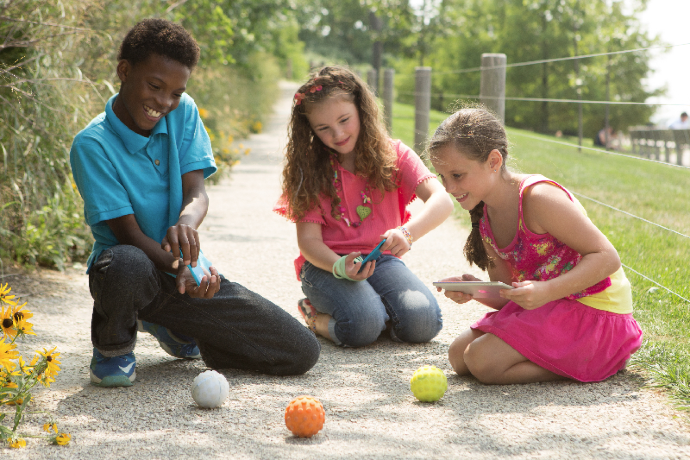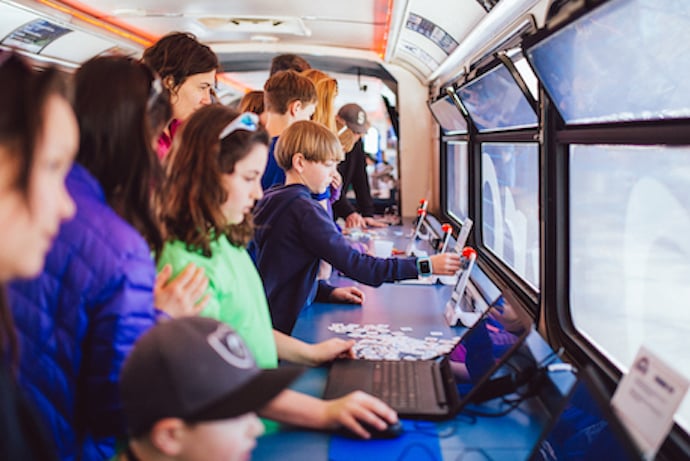If you or your kids are bored and want something challenging and fun, here are three totally different kinds of robots you might explore. Robot Turtles is great for little kids and families. Kids might like using their smartphone (or tablet) to play with Sphero. And ambitious kids in middle school or older might find Mindstorms both amazing and challenging.
All three of these robots also teach computer science concepts and programming in ways kids find easy to grasp. With Robot Turtles, for example, you might not even notice the programming concepts as you use cards to direct your turtle.
Lego Mindstorms
Sensors, motors, and Legos mix with a brick computer and basic software language to create robots. Kids get to learn a little hardware and software, as well as the skills (and patience!) needed to design, build, and test both. There’s also an online community, books, and lots of resources available. The latest version of Mindstorms includes WiFi to connect your robots with a network.
Mindstorms is great for kids and adults who want a hands on experience thinking up robots, building them, and learning a little software to control the robots and bring them to life. The robots are easy enough to learn how to build basic ones then graduate to more complicated robots with combinations of sensors and motors. It’s also possible to replace the software with Java or C and use Mindstorms to graduate to more complicated languages. Your limits are your creativity, the parts Lego provides, your budget, and how much time you have available.
The EV3 (and before it, NXT) programming language used in Mindstorms, oddly enough, originally comes from the Logo language in the 1960s, the inspiration for the Robot Turtles game. Even the name Mindstorms comes from a book title from one of the creators of Logo.
Sphero
There’s lots of neat things about Sphero. It’s round and you control it with your smartphone or tablet. It has a nubbly plastic wrapper. It can travel up to 7 feet a second. You can program Sphero. And you can turn one or more rooms in your house into an arcade with Sphero running around to do things in the room.
Perhaps the most interesting part about Sphero is its simplicity. It’s both attractive and a liability. Instead of sensors and gears like Mindstorms, or cards you can use to direct a turtle like Robot Turtles, Sphero is simple. It’s a cute small ball and some software you download to your phone or tablet. Then you can easily connect to your Sphero and noodle with the software to make it do things. You can accessorize Sphero with some colored nubbly cases. And the ball can turn colors.
But continuous engagement requires diving into learning to program the robot, playing with different options as well as playing games. Kids Ruby also lets kids use the Ruby language to program their Sphero. There are also a lot of YouTube videos showing how people use their Spheros.
I bought this last Christmas and find it to be lots of fun. The hardest part was waiting for my Sphero to charge up the first time. It costs about $99 but there are deals on the Sphero site and elsewhere online like ThinkGeek.com.
Robot Turtles
The most backed board game in Kickstarter history is a game to teach kids about ages 5-8 basic programming concepts as they play along and have often silly fun. It’s available in the US in June 2014 in Target stores and elsewhere for about $25. The game is inspired by Logo, a programming language from the 1960s which used a turtle as a cursor graphic. In the Robot Turtles game, kids use cards to program their Robot Turtle to reach a matching jewel. The cards progress to obstacles like Ice Walls and Lasers. Kids get to boss around the grown up in the game, turning them into a computer.
Kids and families also learn key concepts for computer science (and life!): how to break big problems into small ones, working backwards from goal to solution, how to handle mistakes (aka bugs), how functions work, and more.
For even more fun, there’s an online community called Robot Turtles Adventure Quest Imagination Center where kids and families can write their own story, create a game board, create a Frog Favorite card, play the game their way, and then share their work with other kids and families. It’s a great way to be inspired, be creative, and have more fun with the Robot Turtles game.
There’s also an expansion pack called Robot Turtles Adventure Quest with extra game play. The expansion pack is bundled with the Robot Turtles game or sold separately.
The best part? Robot Turtles is a board game. No computer is required. The game teaches coding and problem-solving skills as kids have fun. It’s a game for kids alone or for family and friends. Some families replace the turtle with a child and use the cards to order the child through the game, or a parent. It’s that flexible and fun to play.
Learn More
Lego Mindstorms
http://www.lego.com/en-us/mindstorms/
http://www.lego.com/en-us/mindstorms/downloads/software/ddsoftwaredownload/
https://en.wikipedia.org/wiki/Lego_mindstorm
http://www.lego.com/en-us/mindstorms/gettingstarted
http://www.us.lego.com/en-us/mindstorms/community
Sphero
http://www.gosphero.com/sphero-2-0/
http://www.gosphero.com/education/
http://www.kidsruby.com/
Robot Turtles (and Robot Turtles Adventure Quest Expansion Pack)
http://www.robotturtles.com/
http://www.thinkfun.com/robotturtles/adventure/
http://www.thinkfun.com/robotturtles
https://www.kickstarter.com/projects/danshapiro/robot-turtles-the-board-game-for-little-programmer
http://duxter.com/robotturtles
Logo Programming Language
https://en.wikipedia.org/wiki/Logo_%28programming_language%29
http://el.media.mit.edu/logo-foundation/logo/programming.html
http://el.media.mit.edu/logo-foundation/resources/links.html
http://el.media.mit.edu/logo-foundation/resources/discussion.html
http://www.transum.org/software/Logo/
http://turtleacademy.com/
http://logo.twentygototen.org/
http://movetheturtle.com/










